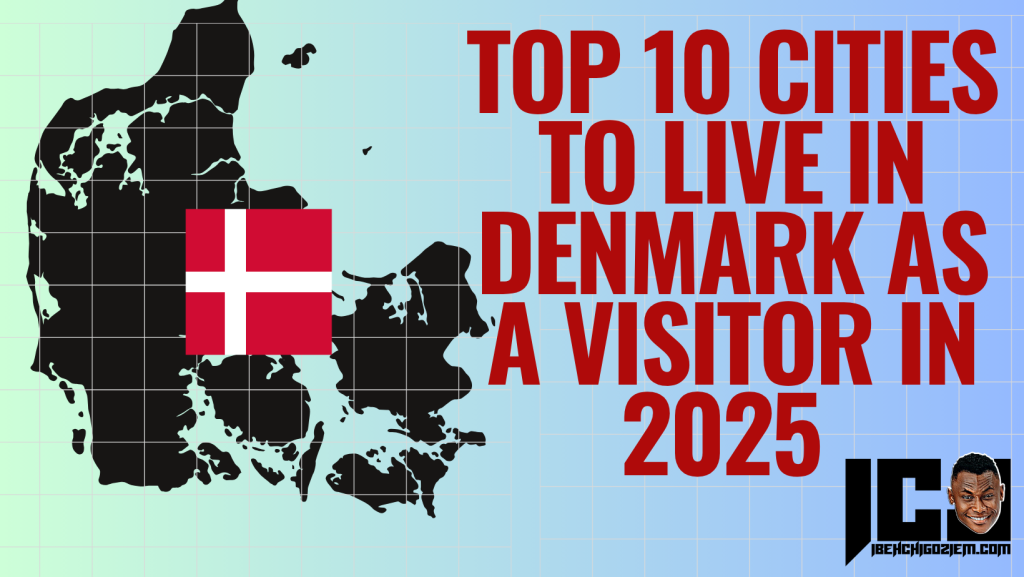Top 10 Cities To Live In Denmark as an Immigrant In 2025
Living in Denmark as a visitor in 2025 is like stepping into a lifestyle that values balance, beauty, and simplicity. Whether you are in it for the design, the bike rides, the fresh air, or the pastries, you will find something memorable. Although it is not the cheapest destination, its safety, infrastructure, and cultural richness make Denmark a worthwhile experience.
Brief History of Denmark
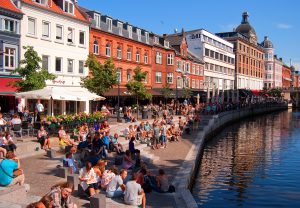
Denmark is a small Scandinavian country located in Northern Europe which has a rich and complex history that stretches back thousands of years.
This country is known today for its high quality of life and progressive society. Denmark’s past is deeply rooted in Viking heritage, monarchy, and centuries of political transformation. The earliest human presence in Denmark dates back to around 12,000 BCE, during the end of the last Ice Age.
Over time, small tribal societies developed, gradually transitioning into more organised communities. By the Iron Age, the Danes had emerged as a distinct Germanic people. The Viking Age (circa 800–1050 CE) marks one of the most significant periods in Denmark’s early history. Danish Vikings were known for their seafaring skills, exploration, and raids across Europe.
ALSO, READ Top 10 Cities to Live in Canada As A Visitor Or Immigrant in 2025
They established settlements and trading posts throughout the British Isles, France, and as far as the eastern parts of Europe.
Danish King Gorm the Old and his son, Harald Bluetooth, were key figures during this time. Harald famously unified Denmark and introduced Christianity around 965 CE, marking a crucial cultural turning point.
After the Viking era, Denmark evolved into a Christian kingdom. During the 12th and 13th centuries, Denmark expanded its territory under a strong monarchy. During this period, King Valdemar the Great and his successors established Denmark as a regional power, controlling parts of modern-day Sweden, Norway, and northern Germany.
In 1397, Denmark entered a political union with Sweden and Norway called the Kalmar Union, under Queen Margrethe I.
The union was meant to strengthen the Scandinavian kingdoms against German influence but eventually became dominated by Danish interests.
However, tensions led to Sweden’s departure in the early 16th century, while Denmark and Norway remained united until 1814.
The Reformation and Absolute Monarchy
The 16th century brought major religious change with the Protestant Reformation. Denmark officially adopted Lutheranism in 1536 under King Christian III, dissolving the Catholic Church’s power and confiscating its property.
In 1660, Denmark transitioned into an absolute monarchy under King Frederick III. This period saw centralization of power and the development of a bureaucratic state. While the monarchy was strong, Denmark also experienced military defeats and territorial losses, particularly in conflicts with Sweden.
Denmark experienced the Napoleonic Wars though Denmark initially tried to remain neutral. However, Britain bombarded Copenhagen in 1807 to prevent Denmark’s fleet from falling into French hands, prompting Denmark to join the war on the side of Napoleon.
After his defeat, Denmark was forced to cede Norway to Sweden in 1814, ending a centuries-long union.
The 19th century was a time of modernisation and political reform. Denmark adopted its first democratic constitution in 1849, moving away from absolute monarchy.
The country also underwent industrialisation, although it lagged behind other European powers.
However, Denmark suffered a major blow in the Second Schleswig War of 1864, losing the duchies of Schleswig and Holstein to Prussia and Austria.
ALSO, READ: Top 10 Cities To Live In London As A Visitor 2025
This defeat marked the end of Denmark’s ambitions as a European power and led to a focus on internal development.
Denmark remained neutral during World War I but was occupied by Nazi Germany during World War II from 1940 to 1945.
After the war, Denmark became a founding member of the United Nations and later joined NATO in 1949 and the European Economic Community (now the European Union) in 1973.
In recent decades, Denmark has built a reputation as a democratic, socially progressive country with a strong welfare system and a constitutional monarchy.
Denmark’s history is a blend of warrior culture, monarchy, and modern democratic values. From its Viking roots to its current role as a model welfare state, Denmark has continually adapted to the tides of history while maintaining a strong cultural identity.
Life in Denmark as a Visitor
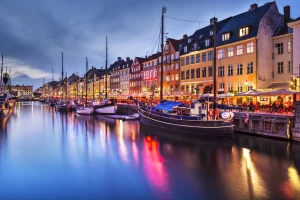
Visiting Denmark offers a unique opportunity to experience one of the worlds most progressive, peaceful, and livable countries. As a visitor, you will discover a society that values equality, environmental consciousness, and quality of life.
Denmark is made up of welcoming locals, well-maintained infrastructure, and high levels of English fluency, Denmark makes for a smooth and enjoyable stay for its visitors
Here are some of what you can expect when living in Denmark as a visitor in 2025.
- Safety and Security
Denmark consistently ranks among the safest countries in the world. Crime rates are low, and trust in public institutions is high.
Whether walking through city centers at night or exploring rural towns, visitors usually feel secure. Police presence is discreet but effective, and emergencies are handled efficiently.
In case of any emergency during your stay in Denmark you can dial the emergency number 112 for quick response.
- Hospitality and Local Attitude
Danes are known for being polite, respectful, and private. While they may not initiate conversation often, they are extremely helpful if approached.
Most Danes speak excellent English, especially younger people and those in urban areas. You will rarely feel out of place as a visitor.
- Amenities and Public Services
Denmark offers top-tier public amenities. Visitors benefit from:
Efficient public transport (buses, metro, trains, bikes), Free Wi-Fi in public spaces and cafes. As a visitor you can have access to public libraries with English-language resources.
There are also high-quality health services (emergency care is available even for visitors, though travel insurance is advised). Many cities are bike-friendly with rental systems (e.g. Donkey Republic, Bycyklen in Copenhagen).
- Cost of Living and Affordability
Denmark is relatively expensive, especially compared to other European countries.
Hence it is advisable to cook meals or buy from local supermarkets, try to make use of public transportation and bicycles.
Choose accommodations outside the city center so as to get cheaper accommodation.
- Weather and Seasons
Denmark has a temperate maritime climate throughout the year.
As a visitor that visits during Winter (Dec–Feb) you have to prepare for cold, wet, and dark with average temperature of 0°C–5°C.
During the Spring season (Mar–May) you will experience chilly but blossoming weather and increasing daylight
In Summer season (Jun–Aug) Mild and sunny time (18°C–25°C), with long daylight
ALSO, READ Top 10 Cities To Live In Nigeria As A Visitor In 2025
While in Autumn (Sep–Nov), the weather is cool with colorful foliage and early sunsets.
The Best Time to Visit Denmark is late May to early September for optimal weather and outdoor activities.
- Language and Communication
Danish is the official language, but English is widely spoken, particularly in; Hotels and hostels, tourist attractions, cafés and restaurants, and some public offices in big cities. Hence visitors usually don’t need to learn Danish to get by, but picking up basic phrases is appreciated.
- Tourist Attractions and Activities
Life in Denmark as a visitor is filled with cultural, natural, and historical experiences which may include cycling across cities and coasts, visiting museums and castles.
- Food and Dining
Danish cuisine is hearty and seasonal. While eating out can be expensive, food quality is high.
- Transportation and Getting Around
Public transportation is clean, punctual, and extensive
Trains and metros run between major cities and suburbs while buses and ferries serve local and regional routes.
Biking is often faster than driving in cities like Copenhagen.
- Social Life and Community
As a visitor
Danes value privacy but are inclusive in public and cultural settings. Volunteering or attending language cafés can help you integrate well.
As a visitor in Denmark it will be good for you to respect people’s privacy so that you will not have issues with the citizens.
- Digital and Work Life
Denmark is highly digitally advanced, and you can have access to free Wi-Fi. Wi-Fi is available in most public places.
Also ,coworking spaces are growing in cities like Copenhagen and Aarhus.
Digital nomads enjoy smooth access tothe resources needed.
Top 10 Cities to Live in Denmark as an Immigrant
Denmark, consistently ranked among the happiest and most peaceful nations on Earth, is a top choice for visitors seeking safety, scenic charm, rich culture, and high-quality living.
In 2025, the Scandinavian gem continues to attract travelers looking for a balance of modern comfort and historical depth. With its well-developed infrastructure, welcoming locals, and efficient public services, Denmark offers a unique experience for visitors planning short-term or extended stays.
This article ranks the Top 10 Cities in Denmark to live in as a visitor in 2025, based on security, hospitality, amenities, affordability, tourist attractions, weather, and language accessibility.
- Copenhagen
- Aarhus
- Odense
- Aalborg
- Roskilde
- Esbjerg
- Helsingør (Elsinore)
- Skagen
- Randers
- Vejle
1. Copenhagen

Copenhagen, the capital of Denmark, is a dynamic city known for its rich history, modern design, and high quality of life.
The city is located on the eastern coast of the island of Zealand. it is Denmark’s largest city and cultural, political, and economic center.
Copenhagen was founded as a fishing village. In the 10th century, Copenhagen began as a small fishing and trading settlement and It was originally known as “Havn”, which means “harbor” in Danish.
Copenhagen rose to prominence in the Middle Ages and became the country’s capital in the early 15th century.
The city showcases a mix of historic architecture and contemporary urban planning, with landmarks such as the royal Amalienborg Palace, the colorful Nyhavn harbor, and the iconic Little Mermaid statue.
Copenhagen is renowned for its commitment to sustainability, boasting an extensive cycling infrastructure and ambitious goals to become carbon-neutral by 2025.
It also thrives as a hub of creativity and innovation, with a strong presence in design, fashion, and gastronomy.
The city is home to world-famous restaurants like Noma and hosts numerous festivals and cultural events.
With its blend of old-world charm and modern sensibility, Copenhagen offers residents and visitors a unique and inviting atmosphere, making it one of the most livable and admired cities in the world.
Security
Copenhagen is one of the safest capitals in the world, with low crime and high trust in law enforcement.
Hospitality
The people of Copenhagen are friendly, often fluent in English, and used to engaging with international visitors.
Amenities
Excellent healthcare, public transport, Wi-Fi access, and green public spaces are available, hence making it a convenient place for visitors.
Affordability
Living in Copenhagen is relatively expensive, but budget travelers can find hostels, public bikes, and affordable eateries.
Tourist Attractions
Nyhavn Harbor, Tivoli Gardens, The Little Mermaid, and world-class museums are siyes to behold for tourists.
Weather
Mild summers, chilly but cozy winters. Great during spring and early autumn.
Language
Almost everyone speaks English well.
2. Aarhus
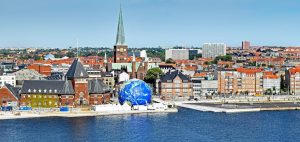
Aarhus is located on the east coast of Jutland. It is Denmark’s second-largest city and a thriving cultural and educational hub; it is home to Aarhus University.
Despite its rich history, Aarhus is also a city of the future. It hosts thriving tech and design industries, supported by institutions like Aarhus University, one of the top universities in Scandinavia.
The waterfront area has undergone major redevelopment, featuring contemporary architecture such as the ARoS Art Museum, with its iconic rainbow panorama.
Aarhus has a youthful, energetic atmosphere. The city blends historic charm with modern architecture, seen in attractions like Den Gamle By (The Old Town) and ARoS Art Museum.
Blending tradition with progress, Aarhus offers the warmth of a small town and the dynamism of a modern city, making it a unique and attractive place to live or visit.
The city also boasts a dynamic music, food, and festival scene. Surrounded by forests and beaches, it offers a perfect mix of urban life and natural beauty.
Security
Aarhus maintains a high level of security with low crime rates, strong police presence, advanced surveillance, and community involvement, ensuring a safe environment for residents, students, and tourists alike.
Hospitality
Friendly student population, helpful locals, and English is widely spoken.
Amenities
Modern infrastructure, great libraries, cafes, and coworking spaces.
Affordability
Slightly cheaper than Copenhagen; ideal for long stays.
Tourist Attractions
ARoS Art Museum, The Old Town (Den Gamle By), and beaches.
Weather
Milder winters than most of Denmark’s interior regions.
Language
English signage and services are common.
3. Odense

Odense is a charming city in central Denmark, known as the birthplace of renowned fairy tale author Hans Christian Andersen.
As one of Denmark’s oldest cities, Odense boasts a rich history, evident in its cobbled streets, medieval architecture, and vibrant cultural scene.
The city blends old-world charm with modern living, offering museums, art galleries, and lively festivals.
Odense is also home to a growing student population, thanks to the University of Southern Denmark. Its lush parks, bicycle-friendly infrastructure, and scenic river make it an attractive destination for both residents and visitors seeking a relaxed yet culturally rich atmosphere.
Security
Odense Security provides reliable, professional security services across Odense.
They specialize in surveillance, event security, and property protection, ensuring safety and peace of mind for businesses and individuals alike.
Hospitality
Warm residents and strong tourism support.
Amenities
Walkable city, decent healthcare, and good public transport.
Affordability
More affordable than major cities; great value.
Tourist Attractions
Odense offers top attractions like the Hans Christian Andersen Museum, Odense Zoo, Funen Village, and St. Canute’s Cathedral, blending rich history, culture, and family-friendly experiences in a charming setting.
Weather
Odense weather is balanced; cooler winters, mild summers.
Language
Most locals speak English; tourism info is well-translated.
4. Aalborg
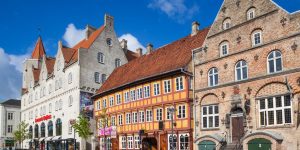
Aalborg is a hidden gem in northern Denmark, Aalborg is known for its strong community spirit, economic growth, and increasing international exposure.
Security
Exceptionally safe; great for solo travelers.
Hospitality
Friendly, with an emerging tourism industry.
Amenities
High-quality transport and municipal services.
Affordability
Lower rent and living costs than major cities.
Tourist Attractions
Utzon Center, Aalborg Zoo, Waterfront Parks.
Weather
Cooler due to its northern location but pleasant in summer.
Language
English is commonly spoken, especially among the young.
5. Roskilde
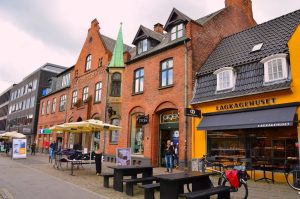
Roskilde, located on the island of Zealand, is one of Denmark’s oldest and most historically significant cities. Once the capital of Denmark during the Viking Age and the Middle Ages, it played a central role in the country’s political and religious life. The city is best known for the majestic Roskilde Cathedral, a UNESCO World Heritage Site where many Danish monarchs are buried.
Roskilde is also home to the Viking Ship Museum, which showcases well-preserved ships and offers insights into Viking maritime culture. Beyond its historical treasures, Roskilde embraces modern culture through the world-renowned Roskilde Festival—one of Europe’s largest music festivals, attracting international artists and thousands of visitors each year.
Surrounded by scenic landscapes and fjords, the city offers a peaceful yet vibrant atmosphere, blending its rich past with a lively present. Roskilde continues to be a cultural and educational hub in Denmark.
Security
Roskilde Festival security ensures a safe, enjoyable experience through crowd management, surveillance, and emergency response. The city-trained staff maintain order, assists attendees, and coordinates with local authorities for maximum safety.
Hospitality
Locals are proud of their heritage and eager to share it.
Amenities
Top-tier museums, schools, and well-kept parks.
Affordability
Cheaper than Copenhagen with better housing deals.
Tourist Attractions
Roskilde Cathedral, Viking Ship Museum.
Weather
Temperate maritime climate, pleasant in summer.
Language
High English proficiency due to tourism and proximity to Copenhagen.
6. Esbjerg

Esbjerg, located on the west coast of the Jutland Peninsula, is Denmark’s fifth-largest city and a key seaport. The city was founded in the 1860s, and it quickly developed into an important fishing and shipping centre.
Today, Esbjerg remains vital to Denmark’s economy, especially in offshore oil, gas, and wind energy industries. The city is known for landmarks like the “Men at Sea” monument and the Fisheries and Maritime Museum.
With a mix of modern infrastructure, cultural venues, and access to the Wadden Sea National Park, Esbjerg offers both industrial strength and natural beauty, making it a dynamic and evolving coastal city.
Security
Esbjerg provides professional security solutions, including surveillance, access control, and on-site guards. We ensure safety and peace of mind for businesses, events, and residential areas across Esbjerg.
Hospitality
A small-town vibe with a helpful community.
Amenities
Compact city with efficient transport and healthcare.
Affordability
One of the more affordable cities in Denmark.
Tourist Attractions
Fisheries and Maritime Museum, Men at Sea sculpture.
Weather
Windy and cool, but sunny in summer.
Language
English is widely spoken, especially in tourism.
7. Helsingør (Elsinore)
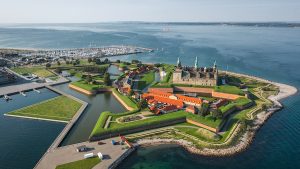
Helsingør, also known as Elsinore, is a historic coastal town in eastern Denmark, famous for Kronborg Castle—the setting of Shakespeare’s Hamlet.
Located on the Øresund Strait, it once played a key role in maritime trade. Today, Helsingør blends rich history with cultural life, featuring museums, charming old streets, and ferry connections to Sweden, making it a popular destination for both tourists and locals.
Security
Helsingør maintains strong security through local police, surveillance systems, and community cooperation. The city prioritizes public safety, ensuring a peaceful environment for residents and tourists with efficient emergency services
Hospitality
Tourism-focused and historically welcoming.
Amenities
Excellent train links to Copenhagen, small-town ease.
Affordability
Reasonable housing and food prices.
Tourist Attractions
Kronborg Castle, M/S Maritime Museum.
Weather
Similar to Copenhagen, comfortable and breezy.
Language
English services are widespread due to tourism.
8. Skagen

Skagen, located at the northern tip of Denmark, is a charming coastal town known for its stunning natural beauty and unique light, which has long attracted artists and tourists.
It lies where the North Sea and the Baltic Sea meet, creating dramatic waves and a striking seascape at Grenen.
In the late 19th century, Skagen became famous for the Skagen Painters, a group of artists inspired by the town’s scenery. Today, Skagen offers sandy beaches, historic yellow houses, and vibrant harbor life, making it a popular destination for those seeking art, culture, and seaside relaxation.
Security
Skagen provides advanced protection solutions, combining cutting-edge technology with expert personnel to safeguard assets, properties, and lives. Trusted, reliable, and proactive—your safety is our top priority
Hospitality
A tight-knit, artistic community that welcomes tourists warmly.
Amenities
Small town with quality services, though limited off-season.
Affordability
Mid-range; more affordable off-peak.
Tourist Attractions: Grenen (where two seas meet), Skagen Museum.
Weather
Windy with long daylight hours in summer.
Language
English spoken in most tourist locations.
9. Randers

Randers, located in central Jutland, is one of Denmark’s oldest towns. It’s known for its medieval charm and cobbled streets, it features attractions like Randers Regnskov, a tropical zoo.
The town blends history with modern living, offering cultural events, shopping, and beautiful natural surroundings along the Gudenå River.
Security
Randers provides reliable, professional security services to safeguard people, property, and assets. With trained personnel and modern technology, we ensure safety through vigilance, integrity, and rapid response solutions.
Hospitality
Less touristy, which can feel more authentic.
Amenities
Basic yet improving, with easy transport links.
Affordability
Among the most affordable mid-sized cities.
Tourist Attractions
Randers Rainforest, Gudenå River, local farms.
Weather
Standard Danish inland climate—cool winters, mild summers.
Language
English speakers are common in service roles.
10. Vejle
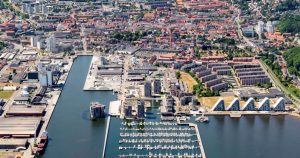
Vejle is a picturesque town located in southeastern Jutland, Denmark. Forested hills and rivers surround Vejle, and it is known for its natural beauty, innovative architecture, and vibrant cultural life.
Historically, Vejle dates back to the Middle Ages and played a key role as a market town and regional trading centre. In the 19th and early 20th centuries, it became an industrial hub, particularly for textiles and manufacturing.
Today, it has transformed into a modern town that balances history, nature, and progress.
One of Vejle’s most striking features is its architecture. The Wave (“Bølgen”), a modern waterfront residential complex, has become a landmark of contemporary Danish design. The town is also home to museums, art galleries, and historic buildings, such as St. Nicolai Church and the Vejle Windmill.
Vejle is a leader in sustainability and green urban planning. Its pedestrian-friendly streets, cycling paths, and focus on renewable energy reflect Denmark’s environmental values.
Vejle provides excellent schools, cultural institutions, and access to nature, it also offers a high quality of life and is an attractive destination for both residents and tourists seeking a blend of tradition and innovation.
Security
Vejle provides reliable and professional security services, ensuring safety and protection for businesses and individuals.
The city also makes available trained personnel and advanced technology, offering surveillance, access control, and emergency response, which delivers peace of mind around the clock.
Hospitality
Residents are welcoming, especially in the arts and food scenes.
Amenities
Great roads, shops, and pedestrian paths.
Affordability
Cheaper than cities like Aarhus or Copenhagen.
Tourist Attractions
Vejle Fjord, The Wave building, forest trails.
Weather
Balanced climate—less windy than coastal towns.
Language
English is understood in all key locations.
Conclusion
In 2025, Denmark remains one of the best destinations for short-term visitors and long-term explorers seeking a balance of safety, culture, and livability. Whether you want the dynamic energy of Copenhagen, the intellectual richness of Aarhus, or the historical tranquility of Helsingør, there’s a Danish city for every kind of visitor. Hence, regardless of which city you choose, Denmark’s high standards of living, public safety, and warm hospitality ensure a memorable stay.
